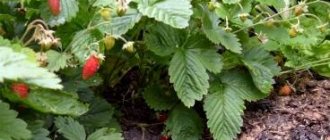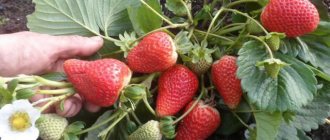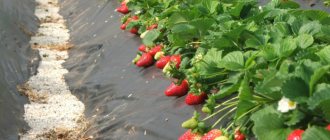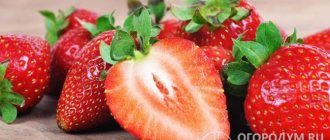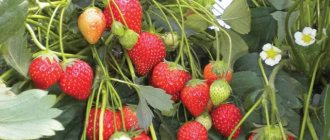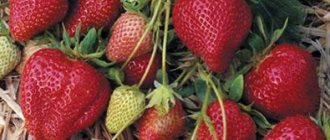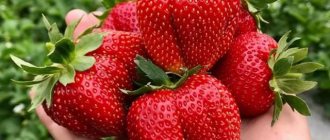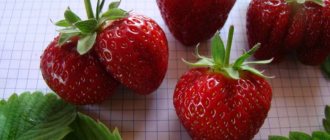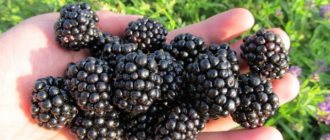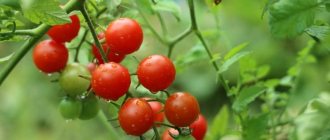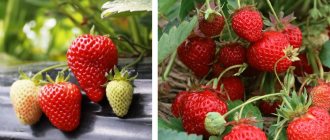Description of the strawberry variety Irma
Developed for the hot conditions of the Apennine Peninsula, the Irma variety revealed its full potential in a mild temperate climate with sufficient rainfall. Strawberry Irma is a day-neutral variety. This means that the plant lays fruit buds every 5-6 weeks, they develop within 2 weeks. The formation of generative buds is not affected by parameters such as daylight hours and air temperature, which can range from 2 to 30°C.
Strawberry bushes of the Irma variety are compact and have medium foliage. The leaf blade is large, dark green. The flower stalks are strong and rise high above the bush. Strawberry Irma produces an average number of runners, spending more energy on the formation of peduncles and ripening of berries.
Advice! To increase plant formation, experienced gardeners pluck flower stalks from strawberries.
Irma strawberries begin to bear fruit in mid-June, along with other mid-early varieties, and do not stop until autumn. The berries are harvested 3-4 times, the largest harvest is at the end of August. In many descriptions and reviews, Irma strawberries are called remontant, however, according to scientific data, at the same time it is a day-neutral crop (NDC). Strawberry Irma produces berries all the time. Flowers, ovaries, and ripe large fruits can be observed on the plant at the same time.
Irma's berries have a multifaceted dessert taste; they are sweet with an unobtrusive sourness. The peak of tasting indicators occurs in mid-summer; early berries have a more mediocre taste.
The fruits are juicy, dense, but not hard, with high sugar content. The skin is glossy, rich red-scarlet in color. The shape of the berry is cone-shaped; by the end of the season the tip may be asymmetrical. The weight of an average berry ranges from 25-35 g, some specimens reach 50 g, and by the end of the season the berries become smaller. On average, you can remove 1-2 kg from one bush per season, with good agricultural technology - 2.5 kg. Irma strawberries are suitable for fresh consumption, as well as for drying and canning.
Care
To ensure that the plant does not disappear and produces a bountiful harvest, it must be well looked after. The main criteria for care are:
- Watering. Strawberry variety Irma is a moisture-loving bush. Based on this, Irma needs to be watered throughout the season. If there is a sufficient layer of mulch on the beds, the soil will not dry out as much.
- Loosening the soil. Be sure to loosen the soil between the rows. This should be done as often as possible, but only before fruiting begins.
- Weed frequently and remove reddened leaves.
- Feeding. Fertilize the soil in a timely manner. To do this, use ash. This is good protection against many pests. It is best if you treat the leaves of the plant with it.
- Removing antennae. If the tendrils are not removed in time, they will begin to take root, which will negatively affect fruiting.
- Preparing for frost. In order for the plant to survive the winter well, you need to stop watering the bushes in time, and also rid them of tendrils and leaves that were previously damaged. After this, mulch the ground. Peat and humus are perfect for this. In winter, Irma needs to be under a thick layer of snow.
Many gardeners additionally protect strawberry varieties by covering them with transparent film as early as September. Thanks to this, the Irma variety will not be afraid of unexpected night frosts and such an unpleasant disease as gray rot.
Pros and cons of strawberries Irma
Every gardener, when choosing a variety of a particular crop, must weigh the pros and cons. It is important to know not only the positive characteristics, but also the possible disadvantages. In describing the advantages of Irma strawberries, one cannot fail to mention the following:
- high productivity;
- resistance to frost and drought;
- good keeping quality of berries;
- excellent transportability;
- excellent taste;
- the berries do not bake in the heat;
- increased immunity to many diseases and pests;
- easily propagated by whiskers.
The disadvantages of the variety include:
- frequent transplantation is required;
- the bush ages quickly;
- enhanced agricultural technology is needed;
- berries crack during the rainy season;
- In hot summers, productivity decreases.
Diseases and pests
Practically does not get sick, but with improper care the following diseases can occur:
- Alternaria blight;
- gray rot;
- mold fungus.
Strawberry whiteflies, aphids, strawberry leaf beetles, and mole crickets can harm strawberries. To protect against diseases and pests, it is necessary to regularly loosen the soil, spray with fungicides at the first signs of disease, and inspect every day to prevent the occurrence of diseases.
To repel pests, you can plant garlic or onions next to the strawberries. Gardeners often use apple cider vinegar. It is diluted with water in a 1:1 ratio. The resulting solution is sprayed onto the bushes. A weak solution of potassium permanganate, which is also sprayed on bushes, will prevent disease. It is acceptable to use mustard powder: it is used to pollinate the soil. This product will help repel larger pests such as slugs.
Planting and caring for remontant strawberries Irma
Reviews from gardeners about Irma strawberries can vary, even negative. This is explained by ignorance of the nuances of growing the NSD variety. Such a crop requires more careful care: a more nutritious substrate, regular watering, and timely application of fertilizers. The plant spends all its energy on planting flower stalks and without the help of a gardener is unlikely to bring a decent harvest. If you follow all the rules of agricultural technology, strawberries of the Irma variety will delight you with a bountiful harvest commensurate with commercial indicators.
Selection and preparation of a landing site
For strawberry beds, it is better to choose a place well lit by the sun, since with a lack of light the berries will become smaller. Irma strawberries need fertile, nutritious soil with a high humus content. It is easy to prepare the soil based on humus yourself by digging up the beds with rotted manure in advance. Irma takes root much worse on clay and sandy soils, as well as with a high alkali content or, conversely, in soil with high acidity. To neutralize a substrate containing a large amount of peat, it is necessary to add the following components:
- dolomite flour;
- slaked lime;
- ground limestone;
- chalk;
- wood ash;
- sawdust.
Comment! The finer the fraction of deoxidizing agents introduced, the faster the reaction will occur, and the acidity of the soil will reach neutral levels.
The best predecessors of strawberries are considered:
- rape;
- radish;
- mustard;
- legumes;
- greenery;
- onion;
- garlic.
These plants enrich the soil with nitrogen as they grow. The Irma variety goes well with such crops as:
- nasturtium;
- Turkish cloves;
- marigold;
- irises;
- sea buckthorn;
- Apple tree;
- grape.
Before planting strawberries, the bed is carefully dug up, removing weeds. It is better and more efficient to loosen the soil with a pitchfork rather than a shovel. In addition to manure, potassium chloride and superphosphate are added to the soil. The beds are formed in the form of rows 60-100 cm wide. Irma strawberry bushes are not particularly spreading, but powerful; ideal for the variety would be planting using the two-line method, when the distance between rows is 35-40 cm, and between plants - 15-25 cm.
Preparation of planting material
When choosing seedlings, you need to pay attention to the appearance of the plant. The rosette should be squat and have 3-5 well-straightened elastic leaves, rich green in color. There should be no stains or mechanical damage on the sheet plates.
The central bud is large, pink or red; if it is more than 20 mm in diameter, you can harvest a small harvest in the first year. Bushes with a green central bud and elongated petioles will not bear fruit in the first season. The place where the central bud grows should not be thick; the wider it is, the older the mother plant from which the tendril was taken was. In this case, the berries will obviously be small, and the seedling will quickly degenerate. If seedlings are sold in flowering form, you should choose specimens with the largest flowers - large berries will ripen on them.
Saplings with an open root system must have light roots at least 5 cm long; the dark color of the rhizome signals that the plant is sick or weakened, and the chances that it will take root are close to zero.
Before planting, seedlings are treated against pests by placing the pot in water at a temperature of 50°C for 15-20 minutes. The procedure is carried out 2 times with a break of half an hour. Hot water kills stem nematodes, mites, and root aphids. In order to prevent many diseases, seedlings are completely immersed in a solution of copper sulfate or copper oxychloride with the addition of table salt for 5-7 minutes. To prepare this product you will need:
- copper sulfate or “Hom” – 1 tsp;
- salt – 3 tbsp. l.;
- water – 10 l.
After soaking in the fungicide solution, the strawberries are rinsed with water and planted in a permanent place.
Landing rules
In the garden bed, dig holes 25 cm deep, the width and length are also 25 * 25 cm. It is advisable to add a well-fertilized substrate, mixed according to the following recipe, into each hole:
- garden soil – 5 kg;
- compost – 5 kg;
- wood ash – 1 tbsp.;
- vermicompost – 1 kg.
The seedlings are placed in the hole and the roots are placed vertically downwards, with the apical bud being slightly above ground level. Next, they are covered with soil, watered abundantly and covered with a thin layer of mulch made from sawdust, grass or pine needles.
Important! Until the young strawberries are well established, all flower stalks must be plucked out so that the bush spends energy on the formation of the root system and green mass.
Watering and fertilizing
Strawberry Irma is a moisture-loving crop. It needs watering throughout the warm season. If the beds are mulched, the soil does not dry out longer.
Comment! The problem of regular soil moisture can be solved by organizing drip irrigation on the site.
Day-neutral strawberries are a plant that works hard. Strawberries of the Irma variety in early spring, as well as during the period of flowering and setting berries, require fertilizing with complex mineral fertilizer. Many people use wood ash for these purposes; they also sprinkle it on plantings to prevent diseases and pests.
Mulching and loosening
Before the fruiting period begins, the soil between the rows of strawberries is loosened at least three times. In addition to sawdust, pine needles and grass, beds can be mulched with peat. Weeds, as they grow, are removed, old, diseased and reddened lower leaves are cut off from the bushes. If there is no need for propagation, all the mustaches are also cut off, this will significantly increase the strawberry yield.
Preparing for winter
Before wintering, watering strawberries is gradually stopped, and mustaches and damaged leaves are cut off from the bushes. Plantings are mulched with a layer of humus or peat. In winters with little snow, especially in northern latitudes, Irma strawberries need to be covered with agrofibre.
Proper planting of garden strawberries
Before planting begins, you need to carefully approach the selection and preparation of the site. After all, the type of immunity it will have and what kind of harvest it will produce will depend on the area in which garden strawberries grow.
The following requirements apply to the site:
- It should be sunny and well ventilated. There should be no drafts.
- The soil should be light.
- The location of groundwater should not be below 1 m to the surface. If this problem is observed, choose another site. If this is not possible, you need to make a drainage system.
- The soil should not be too acidic.
- It is important to plant strawberries after suitable predecessors. For example, it is great if garden strawberries are planted in an area where crops such as radishes, peas, beans, onions, dill, etc. were previously grown. Plants such as potatoes, cucumbers, tomatoes, etc. are not suitable.
After the site has been selected, it must be prepared. Preparatory work is usually carried out 60 days before planting. To do this, carry out the following procedures
- All weeds on the site are removed.
- It is dug or plowed to a depth of 30 cm.
- The site is fertilized with humus. About 6-8 kg of substance is consumed per 1 m2. Also, additionally, you can fertilize the area with wood ash. Consumption per 1 m2 - 200 g.
Once the area is prepared, you can begin planting.
Irma garden strawberries can be planted both in spring and autumn. Spring planting is preferable in cold regions, autumn planting in warmer regions. If you plant garden strawberries in the fall in regions with a harsh climate, there is a risk that the root system will not have time to take root well before the onset of cold weather.
The landing pattern is standard. It looks like this:
- Planting holes are dug in the area.
- The holes are pre-filled with water. For 1 hole it takes about 1 liter of water. Wait until the water is absorbed into the soil.
- Place the seedling in the hole in a strictly vertical position. The root system of the seedling is carefully spread over the hole.
- The seedling is sprinkled with soil. The soil is compacted. Water the hole again with water. The consumption is the same, about 1 liter per plant.
- At the end of planting, you can mulch the holes. This will avoid rapid evaporation of moisture and will also protect the area from the formation of weeds.
We also recommend reading: Description of the Rumba strawberry variety
Reproduction
Like many other varieties, Irma strawberries can be propagated by seedlings and rooting. Each method has its pros and cons.
Propagation by seeds:
- You can sow strawberries for seedlings from February to May.
- To do this, prepare a soil mixture of turf soil, peat and sand in a ratio of 2:1:1.
- Seeds are sown in shallow containers and covered with film or glass until the first shoots appear.
- The temperature in the room with strawberry seedlings should be at 18-20°C.
- Picking is carried out when there are 2 well-formed leaves; young plants are transferred to the garden bed when the 5th leaf appears.
Reproduction by mustache:
- All flower stalks are removed from the mother bush, and the first two rosettes on the runner, the most powerful and healthy, are rooted in separate cups, without being separated from the mother plant.
- When young bushes acquire their own, well-developed root system, they can be assigned to a permanent place.
Advantages and disadvantages
Based on the photos and reviews of gardeners about the Irma strawberry, as well as the description of the variety, the natural conclusion is that the plant is popular due to its obvious advantages.
- Excellent taste properties;
- Stable yield;
- Drought resistance: the berries can withstand the sun;
- High commercial qualities: fruits are dense, shelf-stable and transportable;
- Frost resistance;
- Ease of reproduction through a mustache;
- The strawberry variety is sufficiently immune to damage from mites, fungal infections: gray rot and spotting, moderate sensitivity to Alternaria pathogens.
The disadvantage of the Irma strawberry variety, as follows from the description, is a decrease in fruiting during periods of prolonged heat. Installing a drip irrigation system, as well as shading the strawberry plantings with a net, will help in this situation. Then at the end of the season, gardeners harvest an excellent harvest of Irma strawberries, as can be seen in the photo.
Advice! Shading nets can create, depending on the quality, 30-95% shade, while lowering the temperature for plants to 5-10 degrees.
general characteristics
The Irma strawberry variety is considered remontant, that is, the bushes bear fruit throughout the season. Usually this happens 3-4 times.
The first fruits ripen by the end of May. The berries have an elongated shape, resembling a cone, and are bright red in color. The weight of the berry can reach up to 60 grams. The taste of the berries is brighter in summer and autumn than in spring. The berries are juicy with tender pulp and have a high sugar content.
The bushes of the variety are medium in height, with strong root structures, large leaves of dark green color. There are not too many whiskers, but the flower stalks are developing well.
The variety is characterized by a high level of productivity and excellent resistance to winter frosts. One bush produces 1-2 kg of berries, and with careful care this figure increases to 2.5 kg. Thus, “Irma” (strawberry, the description of which is the subject of our attention) is a fairly high-yielding crop.
Harvesting and storage
The first harvest from the plantings is harvested by mid-June. In the future, the fruits are removed every 2–3 days, otherwise new ovaries will not form.
We recommend reading how to store fresh strawberries.
The collected strawberries are placed in a wooden container in a thin layer. It is not recommended to store berries in plastic containers or bags. Having spread out in containers, the harvest is placed in a cool place and stored for up to 5–7 days.
Growing strawberries is considered a creative process. If the variety is chosen correctly, then the summer resident can achieve significant success. And the Irma strawberry is the most acceptable option that can be cultivated in any area, and the tasty, aromatic berries will be an excellent reward for the work invested.
Growing
The Irma variety gives a particularly good and generous harvest of berries in the second year of growth. And then the strawberry yield declines. For household plots and summer cottages, yields in the third and fourth years are acceptable, provided timely fertilizing is done. Then the plantings of remontant strawberries are changed. Reviews from those who grew Irma strawberries indicate the ability of strawberries to easily propagate by tendrils. This method is easier and more familiar.
Reproduction by mustache
The strawberry variety is easy to propagate as it produces enough runners.
- Gardeners, according to reviews of Irma strawberries and the description of the variety, choose which plants they leave for picking berries and remove the tendrils from them;
- Others grow into future seedlings. But on these bushes the flower stalks are already removed so that the plant can feed the cuttings;
- It is better to root only the first two rosettes;
- The tendrils are left on biennial plants and the plantation is renewed for commercial purposes for the next season.
Propagation by seeds
The method of growing the Irma strawberry variety from seeds through seedlings, according to reviews from lovers of the sweet berry, is more complex and labor-intensive. But the troublesome process ensures the purity of the variety.
- Sow Irma strawberry seeds in February or early spring in containers with soil for vegetable seedlings, covering the top with a thin layer of soil;
- The containers are covered with film or glass, but ventilated and watered daily if the soil is dry;
- It is necessary to adhere to the optimal temperature - from 18 0 C;
- Shoots appear after three weeks. They require maximum lighting;
- The seedlings are moved to a permanent place when 5 leaves are formed on it.
Site selection
Planting and caring for remontant Irma strawberries, as experience shows, will be successful if the appropriate site is selected: sunny, rich in nutrients. If possible, the ideal area for planting this variety may have a slight slope to the southwest.
- Clay and sandy soils should be avoided for planting the Irma variety;
- Soils with very high or too low acidity levels are also undesirable;
- Strawberries grow well in areas where there used to be radishes, garlic, legumes, forage or green crops;
- Humus and compost are added to the soil;
- The addition of peat is also accompanied by 200-300 g of lime or dolomite flour;
- Mineral fertilizers include superphosphate and potassium chloride.
Landing
Strawberries are planted in spring or autumn. But late autumn planting entails low productivity of the first fruiting season.
- The width between double-row strawberry ribbons is 60-80 cm;
- Inside, between the rows, a distance of 35-40 cm is enough;
- The holes are made at a distance of 15-25 cm. They must be dug to a depth of 10-12 cm in order to freely accommodate the roots of the plant;
- For planting, prepared soil is poured into the holes: 1 bucket each of site soil and compost, 2 liters of humus, 0.5 liters of wood ash.
Caring for strawberries is not difficult, but the culture requires attention.
- Regular watering is needed, especially in hot July. Then the soil is slightly loosened, weeds are removed and covered with a layer of mulch;
- In the first year of planting, for a better harvest, the peduncles of the first wave are removed, as well as all the tendrils;
- It is necessary to periodically pick off reddened leaves;
- Strawberry leaves are sprinkled with wood ash. The product serves as a top dressing and protects plants from pests;
- If the berries are still ripening in October, the plants are covered with film or agrofibre;
- In late autumn, the mustache and damaged leaves are trimmed. Humus or peat is placed on the soil and covered with snow in winter;
- In the spring, during flowering and the creation of ovaries, mineral complex fertilizers are applied.
This universal variety with sweet berries will appeal to connoisseurs of fresh homemade produce.
As a result of centuries-old selection, many varieties of garden strawberries have been obtained, including long-bearing ones (remontant ones). From such a variety, it is not easy to choose the strawberries that are most suitable for the garden. The characteristics of the varieties are largely similar, but each has its own advantages. Gardeners call the Irma variety one of the favorites in recent years, combining high yields and excellent taste.
